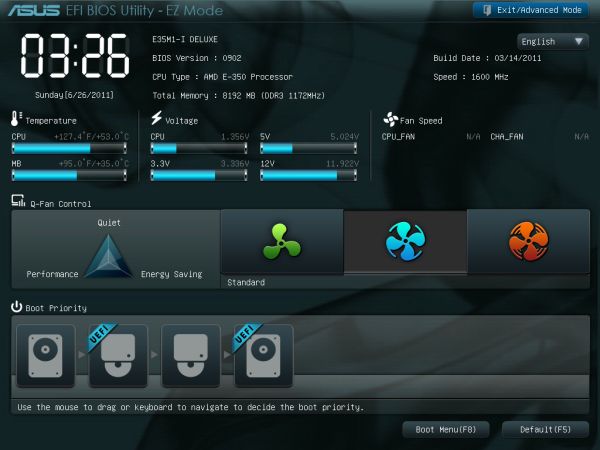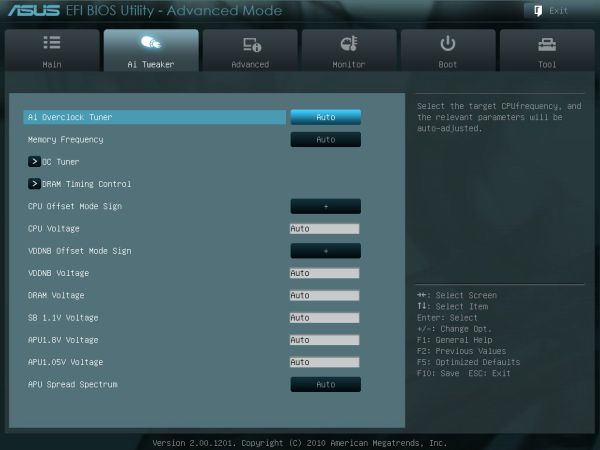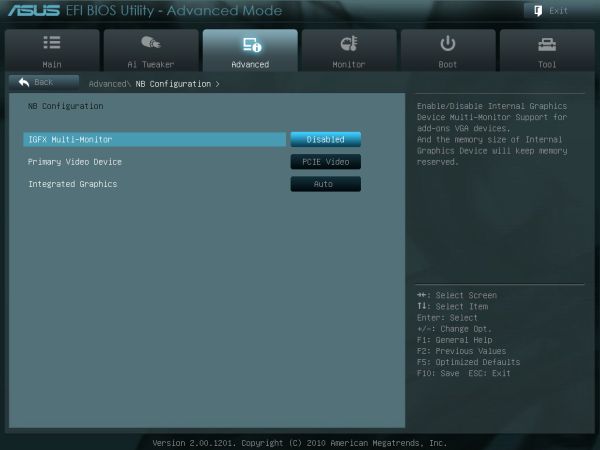Fusion E-350 Review: ASUS E35M1-I Deluxe, ECS HDC-I and Zotac FUSION350-A-E
by Ian Cutress on July 14, 2011 11:00 AM ESTBIOS
The ASUS BIOS solution for Fusion is essentially identical to what we've seen with the Sandy Bridge boards this year - the graphical UEFI implementation, but tailored to the Fusion interface. The front 'EZ mode' (easy, for Brits like me who say 'zed', not 'zee') contains the basic data we want to see - the BIOS version, the CPU, temperatures, voltages, fan speeds, three choices for performance and a quick boot management. This is the cream of UEFI front page implementations, for which ASUS should be applauded. Pressing F12 takes a nice screenshot too.
In advanced mode, 'Ai Tweaker' is where the important action is. First two options are the APU Frequency and Memory Frequency options, followed by OC Tuner (which acts exactly like the Turbo Key switch on the motherboard itself, by applying a default 5% overclock on the next boot) and the memory timing screen.
I actually found a small error in the BIOS here - if you select a manual bus speed overclock, say to 110 MHz, the Memory frequency options change to reflect this 10%, to 880 Mhz and so on. However, if you then decide not to apply the overclock and select 'Auto' on the Ai Overclock Tuner, the Memory Frequency values are stuck at the 10% overclocked values, even if on the next boot they will actually be based off the 100 MHz clock. It's just a small coding error, but odd it wasn't picked up during testing.
Also of interest is the 'NB Configuration' menu. Judging by these options, if you want to run a multi-monitor setup from the integrated GPU (so a HDMI 1.3b and DVI), this option will need to be enabled. However, the help menu mentions VGA devices - whether that explicitly means analog devices or in general video outputs, I'm not sure, but there's no VGA output on this board. So whether it's left over from other boards (the E35M1-M Pro does have a VGA) when they were making this BIOS, again, I'm not sure.
The monitor screen shows us just how hot the CPU is at idle under the passive heatsink - at the time I took this screenshot, we have a CPU running at 52ºC at 1.326 V. In the boot menu, we have the option for a one-off boot device selection, which I think should be a requirement on all future BIOS versions from every vendor.
Just a small after note - the shipping BIOS on the ASUS board is a little unstable. If left alone for a short while, the BIOS will freeze and the only way to fix it is to perform a soft reset. This issue is supposedly fixed with the 0902 BIOS though.
Overclocking
For the ASUS board in this roundup, overclocking was a fraction harder than the ECS. There are two ways to initiate an overclock - from the BIOS/UEFI, or via the Turbo Key II button on the motherboard itself. With the Turbo Key II, we get an instant 5% overclock to take the base speed from 100 MHz to 105 Mhz, and with a 16x multiplier, from 1600 MHz to 1680 MHz. The OC Tuner option in the BIOS has this effect too.
The other alternative is manually adjusting the bus speed from the BIOS. Now as these boards already come with CPUs, the results between boards will be different because of the silicon. With the BIOS, I left the voltage on auto and pushed the bus speed to 110 MHz without issue. At 114 MHz, the board successfully booted but failed the array of 3D iGPU tests in our bench suite. I adjusted it down by 1 MHz until our tests were stable - in the end, only 111 MHz (1776 MHz) was stable enough.
At this level of overclock, the 3D Movement benchmark results were improved by 11.7 % in single threaded mode and 11.0 % in multi threaded. GPU results were considerably different - 21% increase in Metro 2033, 17.3% in Dirt2 and 36% in Left4Dead2, confirming that the CPU or memory is quite the bottleneck in these scenarios.



















67 Comments
View All Comments
ET - Saturday, July 16, 2011 - link
Here are a few links to E-350 reviews using a desktop PSU. Not a comprehensive list by any means:http://www.guru3d.com/article/amd-brazos-platform-...
http://www.overclockersclub.com/reviews/sapphire_f...
http://www.xbitlabs.com/articles/mainboards/displa...
http://www.eteknix.com/motherboards/jetway-nc85-e3...
http://www.tweaktown.com/reviews/4093/asus_e35m1_i...
And of course Anandtech's first review of the platform:
http://www.anandtech.com/show/4134/the-brazos-revi...
ET - Friday, July 15, 2011 - link
In the conclusion you say about the ECS: "Having 33% free of anything is usually a good idea, so when it comes part of the package with very little increase in power consumption, it is a good thing. As a result, all the benchmarks and all the games had much, much higher scores than the other boards we tested."Unfortunately these gaming performance figures don't appear in the article. This looks like an oversight that needs to be corrected.
Mitalca - Friday, July 15, 2011 - link
I second that.Through the review there's a lot of times when Ian talks about the marvell the ECS did with the 33% OC. Then why you didn't show the results?
One of the bigest flaws in this review, that make a lot of people suspect of a way-too-much-biased review.
Testing with a 580 is ridiculous, even if you want to "provide a plausible maximum ceiling". I spend $500 and I only get 50% more frames. What about a U$ 50-100 gpu?? If the CPU and the memory are by far the bottleneck, we should see similar results.
And, once you show the huge benefits that overclocking does to the iGPU, why not try it with the dGPU?
ET - Saturday, July 16, 2011 - link
The main thing I would like to see added to the discrete GPU test is an AMD GPU. The CPU usage of NVIDIA and AMD drivers are different, so results may be different.I don't think that a discrete GPU is worth using with the E-350 in any case, and the test with the GeForce 580 pretty much proved that. It's just too CPU limited.
xorbit - Friday, July 15, 2011 - link
This review is a steaming pile. At least it lends credibility that Anandtech might not be biased, just woefully incompetent.An HTPC review without HTPC benchmarks and coupling the chips with impropper PSU/GPUs.
silverblue - Friday, July 15, 2011 - link
Without wanting to start a huge squabble, if you guys think you could do better...lestr - Friday, July 15, 2011 - link
Tom's already did: Daily Hardware 7/6. 8 boards with more relevant tests though somewhat incomplete.My big question is: WHAT is AMD afraid of? SUCCESS? AMD fanboy but when they could really kick a** they give us another "almost".
Another question: Does the PCIe slot support anything other than graphics? Can I stuff a Hauppauge 2250 or a Ceton card in it? This is totally ignored on almost ALL current ITX boards. You're about as likely to win the Kentucky Derby with a 3-legged horse as playing any games on this platform. What's the point?
The E450 (1.65 / 1333 / HD 6320) is due out any time. Standards on this platform should include 6 audio outs (hello Asus!), mPCIe, fp USB3.. how about DUAL channel memory? What's a few more watts anyway? Is 35W APU too many? RAID?
I wish AMD would pull out all the stops and do this little thing right.. entice the partners as well. If they can't do anything else but bury Atom/NV ... AMD needs to win something sometime.. why not NOW?
Any comments, Ian?
mino - Friday, July 15, 2011 - link
Brazos is sigle channle.There are 35W Llano E2 series APU's on the way.
Brazos is SOLD OUT for 3 quarters allready ... talk about AMD being afraid ...
medi01 - Sunday, July 17, 2011 - link
Idiot detected.Wander7 - Friday, July 15, 2011 - link
Just by looking at the two heatsinks and not doing any measurements, it looks like the Asus' heatsink is suffering from air stagnation because the fins are too close together....